Why do atheists and skeptics want to destroy faith?
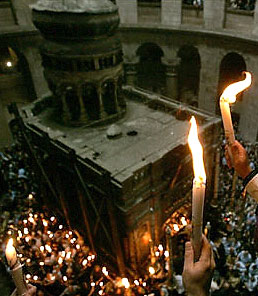 The Holy Edicule after the descent of the Holy Fire
The Holy Edicule after the descent of the Holy Fire
For the two thousand years that unbelievers have been fighting with Christianity, they have never lost their obstinacy. One might pose the question: why do some people, instead of doing something positive, waste so much time and energy trying to disprove facts and causes that they do not believe in and that they have no personal relationship with? Why is it so important for them to destroy someone else’s faith? Why do some people make the dissemination of disbelief their profession? Until very recently, in Russia there were still associate-professors and even full professors of “scientific atheism”.
In the charter of the “Union of Militant Atheists”, the first article was formulated in this way: “the Union of Militant Atheists is a voluntary proletarian social organization whose goal is to unite the working masses of the USSR for the active, systematic and unrelenting struggle against religion, in all of its aspects and forms, since it hinders socialist construction and cultural revolution.”
But now, there is no “construction of socialism”. What, in the eyes of contemporary militant skeptics, is being hindered by the Christianity of millions of people?
The reason for their opposition is found in the demonic nature of atheism, and of all adamant disbelief and skepticism, which in appearance manifest themselves in different forms in different epochs but whose underlying [demonic] nature remains the same. In the times of Soviet atheism, the main root of this phenomenon was found in pride, which led to the God-hating replacing of Christianity by the ideology of an “earthly paradise”; whereas now the fundamental causes of mass atheism are passions and lusts, which the majority of people have fallen into and indulge themselves in. “Disbelief proceeds from a life of vice and from vanity” (St. John Chrysostom, Archbishop of Constantinople +407 AD). [Note: Words are sometimes underlined in this English translation to make clear an emphasis present in the original Russian.—trans.]
Suspicions and conjecture instead of evidence and reasonable arguments.
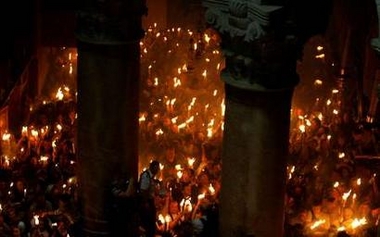
Logic formulates rules for proof and for the substantiation of assertions and conclusions. For the formulation of any conclusion, the premises should be valid; and conclusions should be drawn only when they correspond to (the philosopher and mathematician) Leibniz’s “law of sufficient reason”. In accordance with this law, “for any idea to be valid, there should be sufficient grounds [sufficient reason]; that is, a conclusion should have substantiation [or grounds] proceeding from propositions and assertions that have already been proven.” Skeptics not only themselves doubt the validity of the miracle of the Holy Flame, they also try to convince the rest of the world that every year, for many centuries, a fraud and deception have been committed. How do they try to prove this?
Because the skeptics often make use of the concepts of “eye-witness” and “[personal] testimony”, it is important to turn to the field of Law, or Jurisprudence, as a branch of learning, because centuries–old international legal custom and established legal practices have worked out clear, well-defined criteria which precisely determine who can be admitted as a witness in a court-case. In all systems of law, and even in the everyday use of the word “witness”, a witness is a person who was personally present at a given event, that is, he saw it with his own eyes, was an eyewitness.
Pseudo-witnesses and pseudo-evidence. Skeptics of the Holy Fire use as “witnesses” people who were not participants nor present in any way at the described event. So, for example, they use quotes by Ibn al-Qalanisi* († 1162), al-Jawharī* († 1242), and Mudjir ad-din* († c. 1496). [*The spelling of foreign names, transcribed here from the Russian, may not always be accurate.]
Ibn al-Qalanisi:
“When they are [in the Church of the Holy Sepulchre] on Easter, they hang oil lamps [lampadas] in the sanctuary, and use trickery so that fire will travel to them by means of Balsam-tree oil and devices making use of that oil. It works because one of this oil’s properties is that it catches on fire when it is combined with Jasmine oil. This flame is of a bright light and a resplendent radiance. They cleverly stretch between neighboring oil lamps a taut iron wire as thin as a thread, which runs sequentially from one lamp to another, and they rub it [this iron thread] with the oil from the Balsam tree, hiding this from view until [the oil] has gone along the thread to each lamp. When they are praying and the time of the descent of the sacred flame approaches, the doors of the altar are opened where they believe that the cradle of Isa [Jesus] is—peace be upon Him—and [believe that] from there He [also] ascended into heaven. They enter and light many candles, and in the building it becomes hot from the breathing of the multitude of people. One of the people standing [near] tries to bring [his candle-]flame close to the iron thread, and it [the flame] catches [onto the iron thread] and proceeds to each lamp, from one to the other, until all of them are lit. Whoever sees this, thinks that fire has descended from heaven and lit the lamps.”
al-Jawharī:
“And the thing is that this lampada [oil lamp] is the greatest of tricks, set up by the first generations; I will explain this to you, and reveal the secret: The fact is that at the top of the cupola there is an iron box which is attached to a chain by which it is hung [from the cupola]. It [the chain] is attached to the very dome of the cupola, and nobody sees it except for this monk [mentioned earlier by al-Jawharī]. And on this chain is the box, which is empty inside. When the evening of the “Saturday of the light” approaches, the monk climbs up to the box and puts in it some sulfur similar to a “sanbuseka”, and under it [he puts] fire, [which is all] calculated to the hour when he needs the descent of the holy fire. He rubs the chain with oil from the Balsam tree; and when the time comes, the fire lights the composition at the place where the chain and the attached box meet. The Balsam oil collects at that point, and begins to flow down the chain, going down to the oil lamp. The fire touches the wick of the lamp, which has already been soaked with Balsam oil, and lights it.”
The skeptics took these excerpts from the work of orientalist [specialist in Eastern studies] I.Yu. Krachkovsky (“The Holy Fire” according to the story of al-Biruni and other Moslem writers 10-13th C.//The Christian East. Petrograd, 1915. Vol.3. 3rd Ed. in Russian). They borrowed these statements [quoted above], but either did not read the commentary to them of Krachkovsky himself, or else chose to ignore it.
[Krachkovsky writes:] “In the above-given survey, it is easy to see the main thing distinguishing Moslem stories about the miracle from Christian [reports about it]. The Moslem stories are all understandably brief, sometimes coming down to a simple mentioning (al-Djakhiz, ‘Ali-al-Kherevi); none of them is based on personal observation. The one exception is Ibn-al-Djawzi and its source, al-Biruni, analysis of which we will defer for the time being. The fact that these are transmissions of a third-hand account explains such immediately obvious mistakes, as the date in al-Mac’udi, or Ibn-al-Qalanisi’s report of the belief of Christians about the place of the birth and ascension of Jesus Christ[as supposedly being the same place as His Resurrection]. In these stories, the factual side comes down to very little; from them we can sift out only that, during the whole time relating to the lives of the above-mentioned authors, the miracle took place every year and was a well-known, regularly-occurring event. Description of the miracle itself and of the whole rite is found solely in Ibn-al-Djawsi [this is the eyewitness-account reported by al Biruni which will be analyzed below]. All the remaining elements of the other reports should be regarded not as legitimate, historical accounts but as legendary stories. In one of them, with complete obviousness, are the telling effects of literary editing and reworking of the plot; this is the story [not quoted in this article] about the conversation of the high-ranking person with the monk concerning the “real” cause of the miracle. This story may have arisen as an attempt to give meaning to the destruction by al-Hakim [the mad caliph] of the Jerusalem church through [the literary technique of] his possible conversation with someone in his retinue, as presented originally by Ibn-al-Qalanisi and al-Hariri [spelling?]. All the subsequent versions clearly represent reworkings of the storyline and details, where instead of al-Hakim is a ruler (in Yakut = Al-Kasvini) or al-Melik al-Mu’assam (in al-Jawharī’s story) or, finally, Saladdin himself (in Ibn-al_Djawzi; and instead of someone in his retinue—a monk (in-al-Jawharī), a priest (in Yakut = al-Kasvini) or [even] the patriarch (in Ibn-al-Djawzi).
[The quote from Krachkovsky continues:] The second obvious element in these stories is the attempt to explain away the miracle. This explanation in part comes from the author himself (al-Jawharī, Ibn-al-Djawzi, Mudjir-ad-din), in part is inserted into the story of the conversation of the ruler with the Christian churchman. (Ibn-al-Qalanisi, Yakut). The very diversity of these explanations, and the way they contradict each other, indicate that here also it is hardly possible to expect a basis in fact. In Ibn-al-Qalanisi and Mudjir-ad-din, this explanation comes down to lighting an iron thread which runs to all the lampadas; or (closer to contemporary practice) to one lampada, appearing in Yakuta and al-Jawharī. According to the words of the former [Yakuta], the thread is simply lit; according to the latter, the wick bursts into flame from a complex, hidden apparatus containing sulfur, calculated to a known time. In the latter account, there is also an inner contradiction: at the beginning, he says that all Christians are participants in the conspiracy regarding this “sham” miracle; at the end of the story, however, it is revealed that the secret is known only to the monk who sets up the apparatus.” [End of quote from Krachkovsky’s commentary.]
Filtering of [or sifting through] sources. The skeptics, having set forth from Krachkovsky several “debunking” excerpts from Moslem authors, the stories of whom according to the opinion of I.Yu. Krachkovsky are contradictory and have no “basis in fact”, the skeptics deliberately bypass in silence [or filter out] Krachkovsky’s report of the well-known scholar of Xorezma, Ibu Reixana Muxammeda ibn Axmed al-Biruni [or simply “al Biruni”] (973-1048), who sets forth the story of a person who was actually present at the descent of the Holy Fire. Al-Biruni himself has full confidence in this narrating person, and both of them acknowledge it as a great miracle: “[All] around are [small, natural] little cliffs [inside the Church of the Lord’s Sepulcher] which are like balconies on which are Moslems, Christians, and all who come to the Tomb on this day, bowing down before God and supplicating him from noon till evening. The muezzin from the main mosque and the imam and the emir of the city arrive. They sit near the Tomb, bringing lampadas which they put on the Tomb; and it [the Tomb] is shut. Christians before this extinguish all their candles and lampadas and remain thus until they see that a pure white fire lights the lampada. From it are lighted the lampadas in the main mosque and in the churches; and then they write to the capital of the Caliphate informing them of the time when the fire descended. According to the quickness of the descent and its closeness [in time] to noon, they make a conclusion about [the abundance of] the harvest that year; according to its [the descent’s] delay until evening and distance (from noonday)—about the leanness of the harvest.
This narrating person told me also that once one of the [Moslem] rulers instead of a wick [in the lampada] put copper so that it wouldn’t light and thus the whole thing would collapse. But when the fire descended, the copper itself caught fire. The descent of this fire on a [particular] day [Great Saturday], the date of which changes from year, is not so much cause for amazement as its appearance without visible material, which is much more amazing. It is impossible to have doubts about this….” [this quote from al Biruni is also taken from: I.Yu. Krachkovsky. “The Holy Fire” according to the story of al-Biruni and other Moslem writers 10-13th C.]
This description, coming not from a Christian, but from a Moslem who has no interest in composing anything in favor of Christianity, is sufficient to make useless all the vain attempts of the skeptics. What is most important in this story?
1. Into a Christian church come the muezzin* of the main mosque, and the imam and emir of the city, all bringing lampadas. For what purpose? In order to receive a “pure white fire”. If the Christians received this fire from an already burning lampada or with the help of a “lighter”, then why from this flame do they light all the lamps in the main mosque? [muezzin: the crier who issues the call to prayer five times a day from one of the minarets of a mosque.]
2. Al-Biruni speaks directly about the descent of the fire.
3. Then they write to the capital of the Caliphate about the time of the descent of the fire. Why? In it [the time] Moslems see a sign: according to the quickness of the descent, “they make a conclusion about [the abundance of] the harvest that year.”
4. Al-Biruni writes about one more miracle: “…when the fire descended, the copper itself caught fire.”
It is appropriate here to raise a simple question: If this didn’t really take place, why would a Moslem invent it and elevate Christianity?
And thus the skeptics filter, or sift through, the sources. This sifting of the sources is forbidden by scientific and scholarly methodology. The academic community has undertaken much effort in order to protect the fields of scholarly and scientific knowledge from various fabrications and counterfeits. One point which is directed to the battle against various forms of intellectual fraud is stated thus, “Methodologically forbidden: The ignoring of facts and information substantially differing from the rest, without making note of it.” The skeptics engage in this.
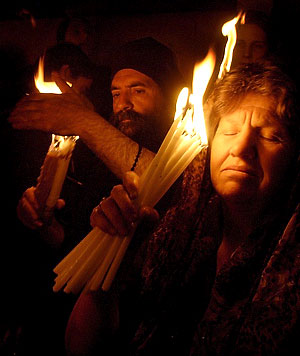 Photo: Micah Walter
Photo: Micah Walter
[*Edicule: the small, free-standing chapel [inside the huge Church of the Resurrection] enclosing the tomb of the Lord. Another name for the Edicule is “Holy Ciborium”.]
Father Mitrophan Papaioannu, who for 57 years was a guard at the chapel [Edicule] of the Lord’s Sepulchre, reported the following particulars to Archimandrite Savva Axilleos: Between 10-11am on Great Saturday [the day before Pascha (Easter)] a rigorous search and inspection is carried out. Special authorized persons enter the Edicule of the Holy Tomb, over which [Tomb] hang 43 golden lampadas; these lampadas burn day and night: 13 of them belong to the Orthodox, 13 to the Catholics, 13 to the Armenians, and 4 to the Copts. These lampadas, like light-bearing angelic ranks, are spread as a canopy over the Tomb of Christ. Into the interior of the Life-bearing Tomb [for this inspection] enter only specially authorized officials in order to, at the last minute before the Patriarch enters, extinguish all 43 lampadas. On the day of the descent of the Holy Fire has been imposed a most-rigorous order which for centuries here has been strictly complied with. On this day without fail, to inspect and monitor everything, are present the representatives of other Christian confessions: the Catholics, Armenians and Copts; together into the Edicule with them also enters the authorized Orthodox representative. Their presence has only one goal: to make sure that there has not been a lampada left burning or some kind of object from which a fire could be ignited, and also that no one is hidden there. The Edicule is inspected three times. Having extinguished all lampadas and candles, the representatives leave the Edicule. The [huge, overarching] Church of the Life-Bearing Tomb of the Lord is plunged into total darkness. Exactly at 11:00 o’clock in the morning of Great Saturday is carried out the procedure of sealing [the entry into] the Tomb. By this time the wax--on which beforehand has been served 40 liturgies—has been prepared; that is, softened in advance for attachment of the seal onto the entry to the Edicule. Then two enormous white ribbons, intersecting each other in the form of the Cross, cover the doors of the entry to the Edicule; the ends of these ribbons flutter, adorning the entry to the Edicule. To the double-doors [of the entry], on all four sides is applied a sufficient quantity of wax; and in the place where the ribbons intersect, is applied the largest part of the wax; and then the entrance to the Edicule is sealed with the official seal of the Patriarch. This procedure brings to mind the hopeless attempt of the Jewish chief priests and the Pharisees, desiring to seal the Tomb of the Author of life with a seal so that His disciples could not steal His body. And coming before the Roman procurator Pontius Pilate in order to receive legal permission for this, they said, ‘“Sir, we remember that that deceiver said, while he was yet alive, ‘After three days I will rise again’”…. Pilate said unto them, “Ye have a watch: go your way, make it as sure as ye can.” So they went, and made the sepulchre sure, sealing the stone, and setting a watch’ (Matthew 27:63-66). After they [these representatives] seal the doors of the Tomb, exactly at 11 o’clock on the morning of Great Saturday begins a procession of the cross around the Edicule. They go around three times. This solemn Cross-procession is accompanied by the singing of psalms; the whole church resounds with wondrous sacred Byzantine hymns. The divine sounds of psalms and sacred songs rings throughout the whole church. The Patriarch and all the hierarchs [i.e., bishops], vested in golden chasubles, process around the Edicule accompanied by all the holy clergy. At the head of the procession go the subdeacons with candlesticks and six-winged ripidia [representing cherubim] in their hands, preceding the precious Cross of the Lord. This solemn Byzantine procession carries the pilgrim to another sphere of being. For a time, all standing and praying here become citizens of Heaven. After the third procession around the Edicule, the Patriarch stops opposite its entrance; at this time they subject him to the most thorough and meticulous search in the presence of the authorized representatives of the other Christian confessions plus the official persons and all the God-fearing people. This inspection is done to eliminate any suspicion about the possibility of the presence on him of some object by which he could light a fire when he goes alone into the Edicule. After this procedure, the Patriarch, wearing only a simple under-tunic, epitrachelion [priest’s stole], and hierarchal [episcopal] omophorion, enters the Edicule. And so exactly at 12 o’clock in the afternoon, the ribbons are cut and the seal is removed from the entrance to the Edicule.” (Savva Axilleos, Archimandrite. I Saw the Holy Fire. Athens, 2002).
I ask your forgiveness for the preceding long quote. I presented it because the skeptics try to convince their readers that this search on Great Saturday is a sham. The atheists consciously disregard the fact that the present custom of inspection of all actions connected with the receiving of the fire (the inspection of the chapel, the seal on the doors, the guards, and also the inspection of the Patriarch) arose under circumstances of a fierce struggle against Christianity by the Moslems, who ruled Jerusalem from the 7th century to the beginning of the 20th (with the exception of the 12th century). The Turkish authorities desired to discredit this phenomenon, and employed every means to prevent the kindling of this fire, because it attests that Christianity is of God. The skeptics cunningly withhold the fact that the Turks, capturing Palestine in 1517 [from the also-moslem Marmelukes], every year for 400 years subjected the Patriarch and the Edicule to a search which was not at all “theatrical”, as some unbelievers insultingly express it.
What prevented the Islamic rulers from proving the Fire to be a fraud, thus unmasking the Christians and depriving them of impressive testimony of the truth of their Faith?
This is what a Russian pilgrim wrote in the 17th century: “And as the Pascha of Christ approached, on the Friday of Holy Week, near vespers, by the order of the Pasha, the Turks (God’s mercy) unsealed the great church—the holy of holies and the Resurrection of Christ; and the Metropolitan, and the Archbishop, and the elders, and every rank of people believing in Christ, pilgrims and local [inhabitants], Greeks and Arabs, entered the church and began to chant vespers[….]And the time drew near to chant the festal vespers, and the Metropolitan went up to the chapel where the Lord’s Tomb was. And the chapel at that time was sealed, and fire was extinguished; and the Turks thoroughly searched the Metropolitan, to make sure that he had no flint(stone), nor kindling, nor tinder, nor sulphur; and that chapel they did unseal for him. And the Metropolitan is at the doors of the chapel and beholds the Deisis [icon of the Virgin Mary and John the Baptist supplicating Christ enthroned], directly to the East, and upwards to heaven he looks, where the broken cupola is, raising praise to God with tender compunction of heart and with tears; and prayed [thus] for two hours. And as the clock struck the 11th hour, over the cupola of that great church, thunder from heaven resounded three times; and the Greeks and the Arabs began to cry out with a great voice, 'Agios, agios, agios', which in our language is 'Holy, Holy, Holy, Lord of Saboath', and they began crossing themselves. After this thunder, three bluish grey doves did come flying [up]; and these three doves sat on that broken cupola: one sat from the East, and the second sat from the South [lit: noonday] and the third to the West. And the metropolitan crossed himself, and went up to that chapel, and was there for a long time; and the revered old man was standing outside that chapel at the doors and often looking into that chapel—now he opens, now he closes. Then above the Lord's Tomb the lampada first was ignited from heavenly fire; and in a short time, from that chapel the metropolitan came out and brought out two bunches of lighted candles in both hands and stood in the High Place* where a place had been prepared for him, and all Christians light their candles from the metropolitan, and the Turks after this lit candles; and that heavenly fire ... not like an earthly fire.” (The Life and Journey to Jerusalem and Egypt of Kazan citizen Vasily Yakovlevich Gagara (1634-1637) //Orthodox Palestinian Collection [of Stories]. Saint Petersburg, 1891. Issue 33. Pp. 33-34.) [*the High Place: the raised place in the very east side of the altar where a bishop sits.]
Could it really be that, over the course of 400 years, the Pasha and his [fearsome] janissaries were so weak and feeble that they would not have to put an end to this custom if it had been a fraud?
The Holy Fire has been descending every year for more than one thousand years. Let us conditionally take as an origin for the miracle the report of the European monk, Father Bernard (c.865 or 870), who unambiguously refers to the miracle of the descent of the Holy Fire: “On Great Saturday, on the day before Pascha [Easter], in the morning church service in the Church of the Lord’s Tomb, after the singing of “Kyrie Eleison” (Lord, have mercy), an angel descends and lights the lampadas hanging over the Tomb of the Lord. The Patriarch passes this fire on to the bishop and finally to all the people, so that each person can light this fire in his own home. The present Patriarch is named Theodosius [863-879]; he was called to this position because of his piety.” (quoted from: Dimitrievsky A.A. The Holy Fire at the Lord’s Tomb on Great Saturday. Saint Petersburg, 1908. p. vi).
From that patriarch, Theodosius, to the present patriarch, Theophilus, there have been72 patriarchs. In the years 1931-1935 and 2000-2001, the Jerusalem cathedra was “widowed”; and the Holy Fire was received by metropolitans. Could it really be that for 11 ½ centuries, not one of the 72 heads of the Church plus several metropolitans, was prevented by his Christian conscience from committing such a grave sin—the intentional and callous deception of a host of believers? One must also add that in the Edicule together with the Orthodox Patriarch is present an Armenian bishop. The previously mentioned guard at the Tomb, Father Mitrophan, relates: “Then with my own eyes, I saw how they sealed with wax the Edicule, [myself] standing there next to them, at the doors to the Tomb. After the solemn Procession of the Cross, exactly at 12 o’clock noon, the doors of the Edicule were opened wide, all the ribbons and wax were removed, and the first to enter in was the Patriarch. After him in the capacity of an observer, followed the representative of the Armenian Church having primacy. A [main] duty of his is to carefully observe every move of the Patriarch. Usually into the second [inner] part of the Edicule, where the Life-Giving Tomb of the Lord is located, he [the Armenian representative] may not enter, [but] only observes the actions of our Patriarch from the Angel-narthex [the immediately adjacent first part of the Edicule].”
The skeptics don’t even consider the moral implications of their activity: in asserting their rightness of their claim, the skeptics must perforce defame all the Patriarchs of the Orthodox Church for one thousand years, imputing each them of lying, mercenariness, and cowardice.
What to the skeptics cite against the factual evidence of the miracle?
[In sum total:] several statements of people who were not eyewitnesses:
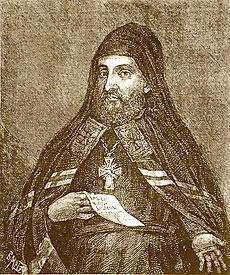
First, it is amazing that the skeptics bring forth this quote at all; apparently they didn’t read it through carefully and didn’t notice that the quote is against themselves, because Melety Smotritsky acknowledges the miracle of the Holy Fire, and then adds that the Fire has ceased to descend because of [the people’s] sins: “regarding this miraculous flame which in former times truly did appear but now because of our sins has ceased to appear.”
Secondly, Patriarch [of Constantinople] Cyril Lucaris never received the fire, and thus his statement is not an eyewitness report in any way. It’s possible to quote in this way any bishop whatsoever.
Thirdly, the skeptics are deliberately pass over in silence both the person and religious convictions of Archbishop Melety Smotritsky. Metropolitan Macarius Bulgakov in “The History of the Russian Church” gives Archbishop Melety this evaluation: “He did not have firm religious convictions, which in great likelihood was first of all a result of his upbringing. His personal religious upbringing took place under three influences: under the influence of Orthodoxy in his childhood, under the influence of strict Latinism [Catholicism] in his youth, and under the influence of Protestant ideas when he had already entered adulthood. The strongest influence was the second, because it occurred in that period of Melety’s life when his mental powers were awakening and waxing in strength; it [this influence on his upbringing] continued during his sojourn at the Jesuit Academy in Vilnius, and was performed by such “masters of their craft” as the Jesuits are. From this, it is not surprising that Melety was not firm in his faith, but constantly vacillated, first to one side and then to the other, depending on the circumstances, until in the end, he gave himself over totally to Latinism….The case of [Meltety] Smotritsky aroused the liveliest of participation in Rome. There was great joy there when they received the report of his acceptance of the Unia*. And Pope Urban VIII himself deigned to send him an epistle in which the Pope welcomed him on his conversion to the Catholic Church from schism and expressed the wish that he endeavour to convert other schismatics. All the writings of [Melety] Smotritsky, beginning with “Apologia”, written in defense of the Unia and Latinism against Orthodoxy, brought forth from among Catholics excessive [or ‘immoderate’] praise. Many, including Cardinals, wrote him letters and hailed him as the most learned of men and as the ‘Polish Cicero’. The Pope himself expressed the wish to have these compositions in a Latin translation—[and so] Melety translated his works and sent them to the Pope; and the Pope directed that Melety’s manuscripts be placed in his select apostolic library in the Castle of the Holy Angel” (History of the Russian Church. Vol. 5, Section 1, ch. 4). [*the Unia; the Uniate Church: Any Eastern Christian church that acknowledges the supremacy of the pope but retains its own distinctive liturgy. American Heritage Dictionary.]
Melety Smotritsky writes [above]: “Even more sharply of this spoke the Patriarch of Jerusalem.” In 1608-1644, the Jerusalem Patriarch was Theophan III. This esteemed patriarch of the mother of all Christian Churches received the Holy Fire for 37 years. If we accept the word of Melety, then it turns out that the Patriarch played the hypocrite the whole time. Why, concerning such a fundamental thing, should we trust a man who betrayed Orthodoxy rather than an honest minister of the Church who battled courageously and succeeded in preserving rights and privileges for the Orthodox Church in the Church of the Lord’s Sepulchre, in the church in Bethlehem and in the cave of the Nativity. The ruler of Palestine, Mohammed-Pasha, arrested Patriarch Theophan for his staunchness and came very close to executing him.
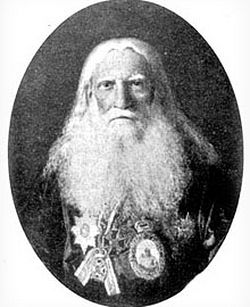
Regarding [Archimandrite and subsequent] Bishop Porphiry Uspensky whom the skeptics quote, those who are familiar with his biography find it impossible to have any confidence in his report about the Holy Fire. Bishop Porphiry is known as the person who attempted to discredit other miracles and traditions accepted by the Church. In the preface to the book “The Posthumous Prophecies of St Nilus the Myrrh-gusher of Mount Athos” (St Petersburg, 1912) [in Russian] we read ,“Printed long ago and widely circulated throughout all Russia are the multi-volume works of Archimandrite Prophiry about Mount Athos. In these thick, heavy books of the deceased Bishop Porphiry (may they not be held against him in the next world), step by step he ridicules and rejects by means of scholarly information almost all Athonite traditions of various miracles, showing very little reverence for Athonite sacred objects and holy places, mocking the Athonites for their ascetic and spiritual labors, etc.; in Russia, one can find these books in every seminary library and in many churches; they are also on Mount Athos in monastery libraries. In short, these widely circulated books of Bishop Porphiry by all appearances have great potential to undermine veneration for the Holy Mountain; however, is this [potential] reflected in any way in the relationship of Orthodox Russia toward Athos, in the amount of her widow’s mites flowing to Athos?! –Not in the least! The Holy Mountain of Athos is under the special protection of the Queen of Heaven. The Mother of God herself, the Queen of heaven and earth, has Athos under her wing.”
This same Bishop Porphiry Uspensky brusquely expressed his opinion about the Sinai Codex (a manuscript of the 4th C), which is a treasure of the Church; he was against Church-use of this priceless manuscript. The well-known traveler and researcher of antiquity Abraham Norov published a special booklet, “In Defense of the Sinai Manuscript from the Attacks of Father-Archimandrite Porphiry Uspensky” (St Petersburg, 1863) [in Russian]. Mr. Norov writes, “After the appearance to the world of the Sinai Bible [Codex], I received news of the brochure published by Father-Archimandrite Porphiry under the title, “Opinion of Archimandrite Porphiry Uspensky about the Sinai manuscript containing part of the Old Testament and all of the New Testament and also the Epistle of the Apostle Barnabas and the Book of Hermes.” I made speed to acquire it, hoping to profit from the investigations of Father Archimandrite, who lived a long time in the East and is well-known for his journey to Sinai and who was the first to point out [the existence of] this codex and in part describe it; but I was struck with amazement and deeply grieved, seeing that the composition of Father Archimandrite is nothing other than a most caustic article directed primarily against the person of Mr. Tischendorf and not able to bear the slightest scholarly criticism and which should never have come from the pen of a man clothed in holy orders. With extreme regret, I take up my pen, but consider it my duty; because the purpose here is not an analysis of the personalities of Father Archimandrite and Mr. Tischendorf but the defense of a sacred written monument cast forth from the flame of Omar, preserved so many centuries on Mount Sinai, held in the hands of holy fathers and hermits who left on it the marks of their reading, and now desecrated and consigned to being excluded from the Church only because—as it is clear from the composition of Fr. Archimandrite—Mr. Tischendorf did not recognize him [Fr. Archimandrite] as the first to discover it [the Codex] in the Sinai monastery. This desecration [i.e., Father Porpiry’s brochure] from a person clothed in holy orders, who says that his opinion “is the fruit of free Bible criticism, and the first-fruit on the soil of our theological literature”, and that “no one, reading it [his brochure] will say consequently that the clergy in Russia does not have its own understanding of the Bible, nor its own seed for sowing, nor a threshing fork for separating the tares from the wheat.” This desecration, I say, might make a deep impression on those who do not know the Greek language and will not hold in their hands this printed publication [of the codex]; but not on those for whom it [the published codex] is available at its [expensive] price and printed in a small number of copies….We would be able to write an extensive article of refutations of all the misinterpretations and false rumors of the father archimandrite, because his opinion presents a wide field for criticism; but for that is required time, and we have hurried to set at rest the minds of those who love the Word of God, concerning the assault of Father Archimandrite Porphiry against one of the most ancient written monuments of Holy Scripture.”
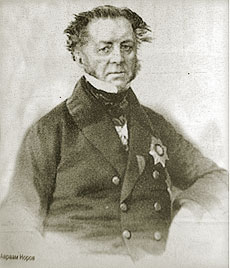 Abraham Sergeevich Norov
Abraham Sergeevich Norov
Returning to the skeptics:
# 3. The skeptics have recourse to one more pseudo-witness. They quote a certain “igumen of the Monastery of the Holy Angels, Hieromonk Gevond Oganesyan of the Armenian Apostolic Church [AAC], who for nine years was present at the ceremony and was personally acquainted with the priests of the Armenian Apostolic Church who entered the interior of the Edicule.” It is a strange and logically feeble argument with a quotation from unnamed “priests of the AAC”. [*igumen: abbot or authoritative member of a monastery]
And that’s their whole arsenal. Not one eyewitness or direct piece of evidence against the miracle for a thousand years!
The report of Professor N.D. Uspensky
Almost all the skeptics quote the speech of Professor N.D. Uspensky given on 9 October 1949, “The History of the Rite of the Holy Fire Served on Great Saturday in Jerusalem.” It is reproduced on many sites. In the eyes of all unbelievers and doubting Thomas’s, it carries weight for two reasons. First, the author was a professor at the Leningrad Theological Academy. Second, he presented it as research.
Against the background of the polemic muddle which usually fills the sites of the skeptics, this report does indeed stand out. However, the rank of “professor” cannot of itself add to a person’s assertions any special cogency; it is well-known that in the 19th C, dozens of European professors (mostly German) who were researching the books of the Bible, ended up becoming disbelievers and denying the Divine inspiration of Holy Scripture.
As concerns the Professor’s actual report, it would be a mistake to call it “research”, because scholarly work pre-supposes a search for the truth and a material-gathering, creative approach to a still-unanswered question. N.D. Uspensky had a negative view before he started his work. All his “research” was directed to corroborate his point of view. Out of an enormous amount of evidence and testimony on the miracle of the Holy Fire, he found several accounts that, so it appeared to him, confirmed his position. Scores of credible eyewitness-accounts in favor of the miracle are simply ignored by the author. Such an approach is not compatible with the scientific method or principles of scholarly research. It is easy to discern the methods the author deliberately resorts to. His conclusions boil down to zero, because he was never present in the Church of the Lord’s Sepulchre for the descent of the Holy Fire, and in fact was never even in Jerusalem.
The preconceived and prejudiced attitude of N.D. Uspensky toward this miracle is seen in an emotionally worded statement at the beginning of his speech: “It would be audacity and disrespect toward God to expect every year a sign from Him.” And what about the Sheep Pool in Jerusalem? “For an angel went down at a certain season into the pool, and troubled the water; whosoever then first after the troubling of the water stepped in, was made whole of whatsoever disease he had” (John 5:2-4). And is it really “audacity and disrespect toward God” that we also every year at the same time (the feast of the Baptism of the Lord) await the “Great Blessing of the Waters”? This miracle in its significance and importance is completely comparable to the descent of the Holy Fire on Great Saturday.
One of the methods of the author is to search out differences between historical accounts of this miracle, and in this way to discredit the witnesses. He quotes Igumen Daniel, who [unlike some other witnesses] saw not a dove or lightning but rather “how it invisibly descends from heaven by the grace of God and lights the lampada in the Tomb of the Lord.” After this, N.D. Uspensky adds, “We notice that Igumen Daniel journeyed to the Tomb of the Lord in the years 1106-1107.” However, after Igumen Daniel, in the letters of our pilgrims [to the Holy Land] are also found similar statements about in what shapes and forms the Holy Fire appears, statements with inner self-contradictions, where the fire descends “like the sun”, yet spreads out on the slab of the Lord’s Tomb “like lightning”, before the eyes of all those present and praying. As an example of self-contradiction, in the “Journeys” of hieromonks Macarius and Sylvester, on pilgrimage in 1704, we read: “On Great Saturday about the ninth hour the fire descends from heaven invisibly into the lampadas, and the fire itself becomes kindled and immediately becomes a divine sign; from heaven comes a fire like the sun over God’s tomb, and from that ray the lampada catches fire; and all God’s people do see the grace in fiery form descending from heaven, as fire moving around over the Lord’s Tomb on the marble slab with every color from heaven, like lightning; and all the people, seeing it, rejoice with exceeding great joy over such divine love of God for man.”
If the author [Uspensky] of the report had used a scholarly, unbiased approach, he would have been tolerant of variations of form in one and the same manifestation in different years. The pilgrim V.Ya. Gagara (1634-1637) relates, as we have already quoted: “ And as the clock struck the 11th hour, over the cupola of that great church, thunder from heaven resounded three times; and the Greeks and the Arabs began to cry out with a great voice, 'Agios, agios, agios', which in our language is 'Holy, Holy, Holy, Lord of Saboath', and they began crossing themselves. After this thunder, three bluish grey doves did come flying [up]; and these three doves sat on that broken cupola: one sat from the East, and the second sat from the South [lit: noonday] and the third to the West. And the metropolitan crossed himself, and went up to that chapel, and was there for a long time.”
Then N.D. Uspensky resorts to the following method. He takes the Holy-Tomb Typicon from the year 1122, in which is contained the order of the service [or sequence of the prayers] reflecting the church-service practice of the Jerusalem Church of the Resurrection in those times: “The people with unceasing voice cry out, “Lord, have mercy.” Then the patriarch with those surrounding him enters the holy Tomb, prostrates three times and prays and beseeches (God) for himself and for the people. Then he kindles [something] from the holy light and gives [it] to the archdeacon, and the archdeacon to the people.” This ancient testimony of the miraculous fire is valuable since it is not merely the observation of a pilgrim: by virtue of the fact that the miracle takes place every year, it is spoken of even in the local Typicon. Since in books containing monastery rules and rites, the light from a lampada is not usually called a holy light, to any unbiased person there will be a clear understanding of what is being talked about here. However, Uspensky, already having a negative, critical goal, turns to some tortuous logic. He takes two earlier books of rites and rules (the Latal manuscript from the early 9th C and the Kal manuscript, late 10th-early 11th C) and quotes them in detail. These manuscripts do not mention the holy fire, but say, “He gives a kiss to the priests and deacons, they bless the candles and light the lampadas;” at this point the author Uspensky unexpectedly draws a conclusion: “This is a simple and clear answer to the puzzling words of the Holy-Tomb Typicon ‘then he kindles [something] from the holy light.’”
For such an assertion there is absolutely no foundation. If one is speaking about three manuscript-variations of one single text, then a research problem would arise: how might the divergence in texts have arisen; and which variation is more authoritative? But here we are talking about completely different texts; furthermore, of different times. The author himself admits: “Between these [Latal and Kal] manuscripts and the Holy Tomb Typicon of 1122, there are many differences. In the Holy Tomb typicon, the rite of the Holy Fire takes place in the middle of vespers, after the reading of the paramia [Old Testament readings]; while in the Latal and Kal manuscripts, at the beginning of vespers. Second: In the Holy Tomb typicon, the rite of the Holy Fire is preceded by the rite of the washing of the lampadas and their preparation; no such separate rite is mentioned either in the Latal or the Kal manuscripts. In the Latal manuscript, the clergy, having entered the church through its [previously] closed doors, “light candles”; and in the Kal, “prepare three censers” [for censing with incense]. And this preparation for the rite is thus directly connected with the rite itself. Third: In the Holy Tomb Typicon, all three censings are done in silence; and the actual rite of receiving the Holy Fire is accompanied by the “secret prayer” [i.e., said in a low voice] of the Patriarch, with three prostrations and the accompanying many-times-repeated chanting of “Lord, have mercy.” In the Latal and Kal manuscripts, the censing around [the inside of the church] is accompanied by the singing of a psalm, litanies, and the reading of a prayer. Fourth: In the Holy Tomb Typicon, during the performing of the rite, the people are present in the church; and for the receiving of the Holy Fire, the Patriarch and clergy go into the interior of the Edicule; but in the Latal and Kal manuscripts, the rite is performed in the absence of the people, and the Patriarch does not enter the Edicule for the Holy Fire, but rather in the church itself ‘they bless the candles and light the lampadas.’”
We intentionally set off in bold type the end of the last sentence to show that there is no foundation for considering the rites of the Latal and Kal manuscripts to be a description of that rite which is spoken of in the Holy Tomb Typicon. Therefore there is no foundation for making a definitive conclusion (such as the Professor makes).
These are the sum total of Uspensky’s arguments to justify his lack of faith in the miracle. The remaining part of his report contains the author’s explanation of how the rite of the descent of the Holy Fire came to be. His basic thought is that “an Old Testament custom has entered into the New Testament Church and received a new ideological meaning.”
It needs to be pointed out that the author of the report’s attitude toward the miracle of the Holy Fire is far from happenstance. In such a fundamental theological issue as the understanding of the mystery of the Eucharist, Uspensky held to Lutheran opinions. Respected archpriest and theologian Father Valentine Asmus, in his work devoted to the patristic understanding of the Eucharist, writes: “Uspensky abundantly quotes the Eucharistic passages of John Chrysostom with their striking realism, but he calmly obliterates that realism with one phrase by calling them a mere “technique of oratorical expression.” The sole theological expression of the views of John Chrysostom on the Eucharist that Uspensky recognizes is the “Epistle of Chrysostom to Caesarius”. Unfortunately, this Epistle is not the work of Chrysostom. It is printed both in Mignes’s Patrologia and in the St Petersburg edition of the Russian translation of Chrysostom under the category of false, or spurious (spuria), compositions of the Hierarch; the most authoritative modern index of patristic works, Clavis Patrum Graecorum (Turnhout, 1974. Vol. 2) also places the Epistle to Caesarius in the category of spurious works. Also convincing [that it is spurious] is an unbiased reading of the Epistle, which obviously dates [later] to the time of the intense Christological disputes. The Epistle is preserved in full only in the Latin. Uspensky, quoting that place in the Epistle where the word “natura” is used, substitutes for it the Greek word “physis”, not mentioning that he has done a reverse translation. Uspensky, attributing to Chrysostom the teaching of the unknown author of the “Epistle to Caesarius” and his own personal view, asserts that this teaching is official Church dogma by the fact that it was not condemned by the Council under the Oak. But this Council could not condemn the teaching of the Epistle to Caesarius, firstly, because it was judging Chrysostom, to whom the Epistle does not belong, this Epistle being written decades after Chrysostom’s death; and secondly, because the Council under the Oak in general did not put forward a single theological accusation. Amazing is the phrase of Uspensky: “If the Church had denied the existence in the consecrated gifts of the physical nature of bread and wine, then that [denial] would have served for the monophysites as a good argument against the [Orthodox] di-physites” (p. 20). In actual fact, the Orthodox do not recognize in the Eucharist a dualism of Eucharistic substances or [a dualism] of the Divine Hypostasis of the Word, but a duality of the Divinity and humanity of Christ, appearing miraculously in the mystery of the Eucharist. Thus loosely treating patristic teaching, Uspensky is even more loose in his treatment of Catholic authors. For example, Uspensky attributes to Thomas Aquinas the assertion that “the Eucharist represents the renewal of the essence of Christ’s sacrifice on Golgotha, and therefore can be called the immolation [sacrifice, as of a lamb] of Christ.” But in actual fact, Thomas Aquinas affirms that the accomplishing of the Eucharist is “a certain image representing ((Евхаристия // http://www.patriarchia.ru/db/text/97468.html in Russian).imago quaedam repraesentativa) the passion of Christ, which [passion] is His true immolation (immolatio)” (part III, quest. 83, art. 1). This speech [or report] of Uspensky did not go unanswered. Deacon Andrew Yurchenko addressed an anxious letter to the Church hierarchy. His Holiness Patriarch Pimen entrusted the Moscow Theological Academy with making a pronouncement on the issue, and the Academy in the person of Professor V.D. Sarychev affirmed the orthodoxy of the traditional teaching of our Church about the Eucharist and the unorthodoxy of the understanding of the Eucharist set forward by the Leningrad professor. The ideas of Nicholas Dmitrievich [Uspensky] were officially refuted, and Church teaching remained unshaken”
The lengthy quotation given above does not relate directly to the topic we are discussing, but it clearly describes a noticeable and significant trait of N.D. Uspensky—arbitrary interpretation of texts. His whole report “On the History of the Rite of the Holy Fire” which the skeptics so value, is constructed on this arbitrariness.
This year during Passion week [April, 2008], arose a new, perhaps the biggest, wave of publications against the miracle of the Holy Fire. This wave was caused by Deacon Andrei Kuraev, who was present at the meeting in Jerusalem in April, 2008, between Patriarch Theophilos and journalists from Russia. After he returned to Russia, he gave out the following statement [in Russian]: “No less candid was his [the Patriarch’s] answer about the Holy Fire….In the Patriarch’s speech was neither the word ‘miracle’ nor the word ‘descent’. About a cigarette-lighter in his pocket he probably could not have spoken in a more candid way.”
The year before [2007], he had been the TV commentator on a live broadcast of the descent of the Holy Fire in Jerusalem, and had spoken of it as a visible affirmation of the truth of Orthodoxy.
What happened during that subsequent year? How did he lose his faith in the miracle of the Holy Fire?
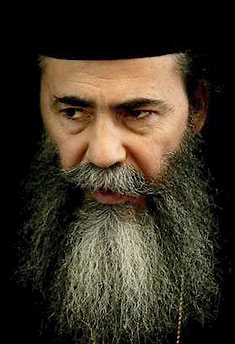
Patriarch Theophilos’ answer consisted of two parts. In the first part, he spoke of the ritual aspect; therefore he used the words “ceremony” and “representation”.
What is a ceremony? The word “ceremony” is from the Latin “caerimonia”, religious rite, religious worship, and in this context refers to the ritual procedures observed at religious or formal occasions. And the concept of “representation” also indicates the external aspect of an action. During any sacrament, baptism for example, besides the concrete action of the grace of God, there is the visible ritual aspect, i.e., “ceremony, representation”. Having spoken of this ritual aspect, Patriarch Theophilos then speaks of the spiritual side of this event: “Now the second part of your question; this pertains to us personally. This is an experience which, if you please, is analogous to the experience which a person has when he receives Holy Communion. That which happens then [at Holy Communion] is parallel to the ceremony of the Holy Fire: sometimes a particular experience is not possible to explain, or to express in words.”
Deacon Andrei gave a completely arbitrary interpretation of the Patriarch’s words “ceremony” and “representation”, ignoring his following words (about the spiritual side) which convincingly show that the primate of the Jerusalem Church is speaking of the genuineness of this grace-filled event: “This is an experience which, if you please, is analogous to the experience which a person has when he receives Holy Communion.” The Patriarch’s meaning is utterly clear, because in the sacrament of the Holy Eucharist, we receive the genuine Body and genuine Blood of our Lord Jesus Christ. (As St Cyril, the patriarch of Jerusalem in the 4th century, says:) “If when He was called to the wedding feast, He performed such a glorious miracle, then even more so—having granted the children of the bridal chamber His Body and His Blood for salvation—does He not require our faith? Therefore with full assurance shall we receive it as the Body and the Blood of Christ. For in the form of bread is given to you His Body, and in the form of wine is given to you His Blood, so that, having partaken of the Body and Blood of Christ, you may become of one Body and of one Blood with Him. In this way we become Christ-bearers— when His Body and Blood are united with our body and blood. Thus, in the words of the blessed Peter, we become “partakers of the divine nature” (2Pet.1:4)….And so, do not consider this to be simple bread and wine, for it is Christ’s Body and Blood, according to the words of our Master [Himself]” (quote from Saint Cyril, Patriarch of Jerusalem (+386 AD).
In the same way as his great predecessor on the Jerusalem cathedra St Cyril, so also Patriarch Theophilos understands Holy Communion. Could His Holiness the Patriarch really have been comparing the great Mystery of the Eucharist with an ordinary fire ignited by a “lighter”? Absurd! The word “lighter” was a self-willed concoction, serving as a stumbling block for those weak in the faith, and giving the atheists a new impulse for “zeal without knowledge” [or “zeal wrongly directed”].
The miraculous origin of the Holy Fire is demonstrated by the fact that in the first minutes, it does not burn or scorch; it is actually possible to “wash oneself” with this fire. How many contrivances have the skeptics dreamed up in order to refute or explain away this distinctive property of the Fire, which in recent years tens of thousands of pilgrims have seen and experienced for themselves.
“Yes, even I, a greatly sinful slave, from the hands of the Metropolitan, lit twenty candles [bound] together and held all of them [together] under my beard, yet not one hair curled up or was singed; and I extinguished all those candles then; kindling from other people, I lit those [same] candles; likewise a third time, I lit those candles [myself];and nothing was touched: not a single hair was burned, nor curled; and I, the wretched one, not believing that the fire was heavenly and a divine sign from God, thus three times [I] lit my candles and extinguished them; and[then] before the Metropolitan and before all the Greeks, I asked forgiveness, that I had hurled abuse on the power of God, and that I had said that the Greeks achieve this celestial fire by sorcery and [that it was] not God’s creation; and the Metropolitan for all these things forgave me and blessed me” (The Life and Journey to Jerusalem and Egypt of Kazanets* Vasily Yakovlevich Gagara (1634-1637) //Orthodox Palestinian Collection [of Stories]. Saint Petersburg, 1891. Issue 33. P. 37). [*Kazanets: citizen of the Russian city of Kazan.]
“Having entered,” he** said, “inside [the Edicule] to the holy Tomb, I saw on the whole [marble slab] covering of the Tomb a sparkling light, similar to small scattered pearls, in appearance white, light blue, crimson, and other colors, which then, joining together, reddened and were transformed over [the course of] time into the substance of fire; but this fire, during the time it takes to say unhurriedly forty times ‘Lord, have mercy!’ does not burn, and from this fire are lit [previously] prepared lampadas and candles. However,” he added, “how and from where this phenomenon occurs, I cannot say” (Hieromonk Meletius. 1793-1794. --**quoting Metropolitan Misail, who received the Fire).
“Vividly I found myself to be on the square in front of the church, where a number of our pilgrims crowded around me. All of them, in tears full of tender contrition and joy, showed me that the Holy Fire does not burn. Many of them in my presence held the flame to their neck, hands and bared chest; and it really does not burn; it begins to burn only when the candle-bunch flares up with a bright flame. Following the example and guidance of pilgrims I knew, I then personally experienced all of this. I encircled with this Holy Fire my neck and hands and arms, and felt no pain whatsoever” (Konstantin Rostovtsev, member of the Imperial Palestinian Society (1896).—from “Orthodox Life”. 1962. No. 4).
“This fire possesses miraculous qualities: in the first minutes, it does not burn; you can apply it to your face, as if washing yourself with it. I myself held it to my face for a while. To speak here of auto-suggestion or self-hypnosis is foolishness: I could not through subconscious suggestion or hypnotism, convince my hairs not to catch fire from a flame” (Archimandrite Raphael Karelin).—http://karelin-r.ru/faq/answer/1000/753/index.html). [Archimandrite Raphael is a highly respected spiritual father and author of spiritual literature in both Russia and Georgia—trans.]
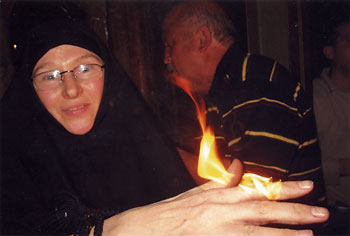 Sister Photinia of the women’s Monastery of St Mary Magdalene, Gethsamane, Jerusalem, 2007
Sister Photinia of the women’s Monastery of St Mary Magdalene, Gethsamane, Jerusalem, 2007
The skeptics try to collect statements of people who maintain that the fire burned or scorched them. It is possible that this really happened; the whole point is in how much time has passed after its descent. Just as the form or appearance of its descent and the duration of the wait for it is not the same in various years, so also varies the length of time the Fire preserves this miraculous property. The just-quoted Archimandrite Raphael Karelin writes: “When I, after a certain amount of time, perhaps five minutes, decided to repeat [holding it to my face], I felt something different—by this time, the fire burns.” Sister Elizabeth of the monastery at Gethsemane says 15 minutes passed, and the Fire still did not burn. There is no contradiction here. If one doesn’t purposely look at a watch, the perception of time can be very subjective. The important thing is the often-testified-to, objective fact that it doesn’t burn.
When the skeptics gather “witnesses” in order to cast doubt on this miraculous quality of the Holy Fire, they once again display incompetence in basic methods of scholarly and scientific research. In genuine scholarly and scientific work, conclusions are based on solidly established, confirmatory evidence. The presence of negative, opposing pieces of evidence induces one only to investigate (as far as it is possible) the causes of their manifestation.
Unbelief and skepticism are barren, infertile. “As someone withdrawing from the light does not in the least do harm to the light, but does very great harm to himself, becoming immersed in darkness, so also one accustomed to scorning the power of the Almighty does not in the least do harm to it [His power], but upon himself brings extreme harm” (John Chrysostom).

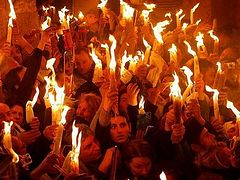
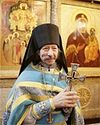
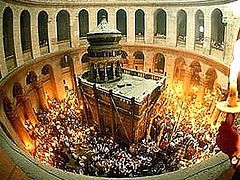
The arrogance of the modern mind is stunning. A "holy hoax" a "martyrdom... a lie"??? What a bunch of foolish sophistry! Lord have mercy!
God bless the Orthodox faithful and may they stand strong against the "faithless and perverse" of our wretched times.
Glory to God now and forever!